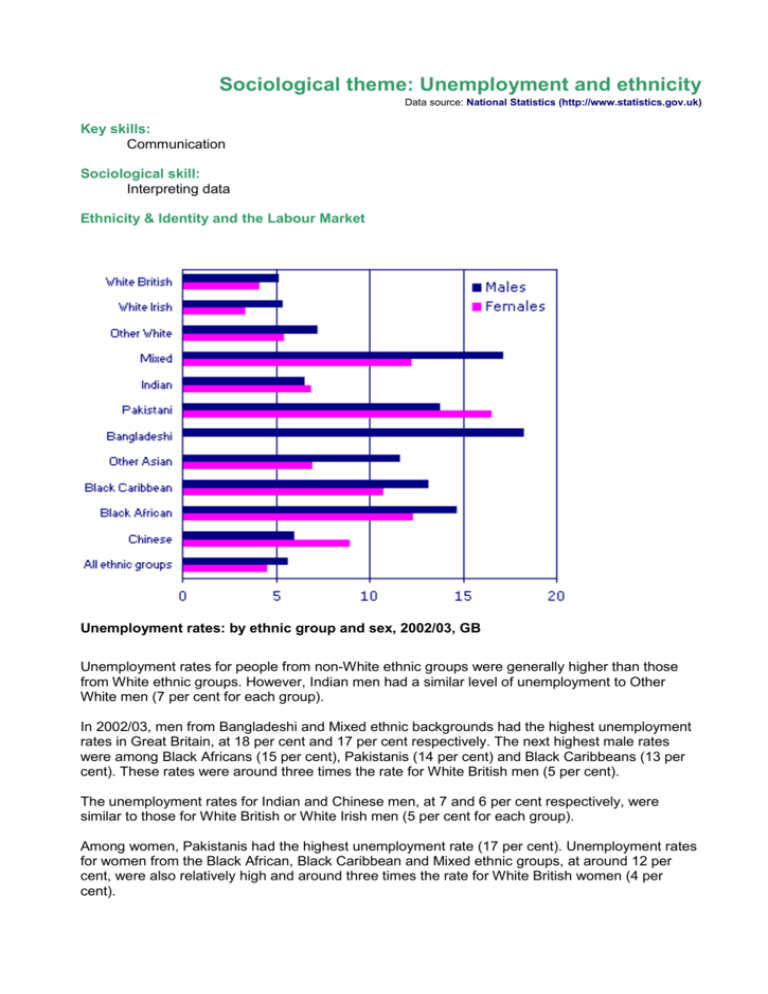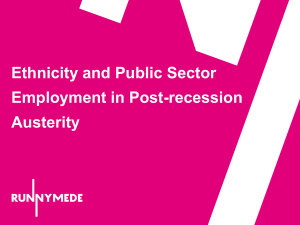Sociological theme: Unemployment and ethnicity
advertisement

Sociological theme: Unemployment and ethnicity Data source: National Statistics (http://www.statistics.gov.uk) Key skills: Communication Sociological skill: Interpreting data Ethnicity & Identity and the Labour Market Unemployment rates: by ethnic group and sex, 2002/03, GB Unemployment rates for people from non-White ethnic groups were generally higher than those from White ethnic groups. However, Indian men had a similar level of unemployment to Other White men (7 per cent for each group). In 2002/03, men from Bangladeshi and Mixed ethnic backgrounds had the highest unemployment rates in Great Britain, at 18 per cent and 17 per cent respectively. The next highest male rates were among Black Africans (15 per cent), Pakistanis (14 per cent) and Black Caribbeans (13 per cent). These rates were around three times the rate for White British men (5 per cent). The unemployment rates for Indian and Chinese men, at 7 and 6 per cent respectively, were similar to those for White British or White Irish men (5 per cent for each group). Among women, Pakistanis had the highest unemployment rate (17 per cent). Unemployment rates for women from the Black African, Black Caribbean and Mixed ethnic groups, at around 12 per cent, were also relatively high and around three times the rate for White British women (4 per cent). Economic inactivity rates for people of working age: by ethnic group and sex, 2002/03, GB Working-age men and women from non-White ethnic groups were generally more likely than those from White groups to be economically inactive, that is, not available for work and/or not actively seeking work. Reasons include being a student, being disabled, or looking after the family and home. In 2002/03 Chinese men had the highest male working-age economic inactivity rate in Great Britain, at 35 per cent, twice the rate for White British men. The vast majority of inactive Chinese men were students. Bangladeshi and Pakistani women had the highest female economic inactivity rates (77 per cent and 68 per cent respectively). The majority of these women were looking after their family or home. Within each ethnic group women were more likely than men to be economically inactive. Questions: Knowledge and Understanding 1. 2. 3. 4. Which ethnic group had the highest unemployment rates amongst males? Which ethnic group had the highest unemployment rates amongst females? Suggest reasons for there being no unemployment rate for Bangladeshi women. How might the unemployment rates amongst non-white ethnic groups be affected by the population of these ethnic groups living in GB? 5. How might the unemployment rates amongst non-white ethnic groups be affected by geographical locality? 6. How might the unemployment rates amongst non-white ethnic groups be affected by gender? 7. Which ethnic groups had the highest working-age economic activity rate for 8. males? 9. Which ethnic groups had the highest working-age economic activity rate for females? 10. What reasons are given for working-age men and women from non-White ethnic groups being more likely to be economically inactive than White groups? Questions: Analysis and Evaluation 1. How might high unemployment rates amongst some non-white groups lead to tensions in communities? 2. To what extent does high unemployment amongst females reflect the cultural backgrounds of ethnic minority groups?








